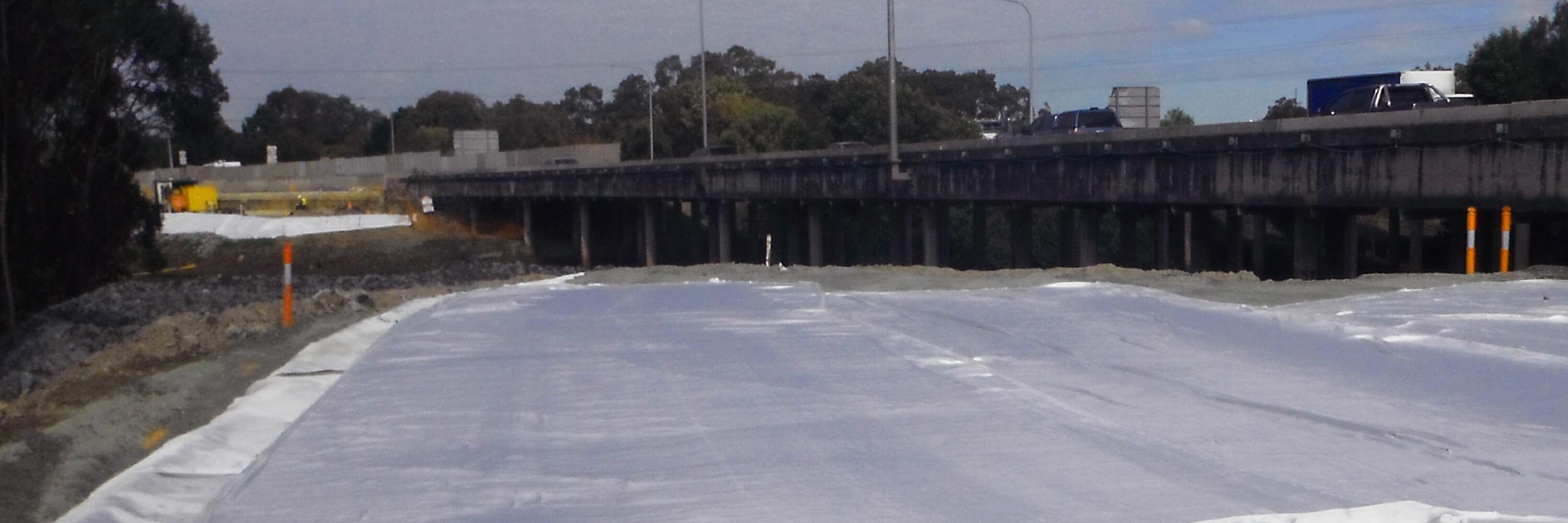The project
Rapid growth in South East Queensland over recent years has created stress on the city roads and connecting arterial roads, one of which is the major North-South connecting Gateway Motorway.
The Queensland Department of Main Roads contracted a joint venture group to construct the Gateway Upgrade Project. Work commenced in 2006 on the 20km upgrade including lane additions, widenings and a duplication of the existing Gateway Bridge river crossing.
The challenges
Many of the realignments selected and the widenings to be created were to be constructed on the flood plain areas of the Brisbane River. This flood plain comprises many soft soil deposits that are in low lying areas with the presence of a high water table.
To traverse the soft and saturated soils, many ground improvement techniques were employed to provide a stable construction platform for the roadway embankments.
One technique to overcome these problems was the combination of Global Synthetics CeTeau® CT-D811 wick drains, ACETex® GT PET woven polyester reinforcement geotextile and ProFab® nonwoven separation geotextiles.
Our solution
Part 1 - ground improvement with nonwoven geotextile
The ground improvement commenced with the placement of ProFab® AS440 nonwoven geotextile over the existing soft subgrade. ProFab® AS440 functions as a separation and filtration layer to separate the soft subgrade soil particles from the imported granular working platform/drainage layer.
The imported granular material layer provides an initial function of a working platform for the ensuing wick drain installation, and over time provides a lateral drainage path for escaping subgrade water during the consolidation phase.
Part 2 - improved drainage with wick drains
To accelerate the consolidation process and reduce lead time for safe embankment construction, Global Synthetics CeTeau® wick drains were then installed vertically through the soft subgrade layers at regular intervals. A triangular pattern of 1.2m spacings was adopted to optimise the consolidation process where excess groundwater could be removed quickly and efficiently by the vertical CeTeau® wick drains. The wick drain depths varied between 5m and 22m.
CeTeau® wick drains consist of a specially designed polypropylene core extruded into a unique configuration to transmit maximum water flow on both sides of the core. The core is fully wrapped in a nonwoven geotextile filter that is ultrasonically welded at the edges to maintain effective filtration.
The CeTeau® drains are inserted into the soil by pushing the product to the desired depth to increase the drainage paths within the soil to be consolidated.
Part 3 - reinforcement with woven geotextile
Once the CeTeau® wick drain installation was complete, the Global Synthetics ACETex® GT PET woven range of high strength polyester geotextile was installed over the granular working platform/drainage layer. The reinforcement geotextile controls stability during construction and provides a reinforcement function during the consolidation phase and throughout the structure's life.
The ACETex® GT PET (polyester) range of products is used for primary applications of reinforcement over extended periods of time. Typically the strength range of this product is between 100 kN/m to 1000 kN/m.
To enhance the consolidation process, the embankment fill/preload fill is placed over the ACETex® GT reinforcement geotextile to the desired vertical height. This fill provided a normal load/surcharge to ‘squeeze’ the free water from the ground through the vertical CeTeau® wick drains.
Find out more about geosynthetics for complex projects
Global Synthetics provides a wide range of geosynthetic products including geotextiles, geogrids, geosynthetic clay liners, turf reinforcement mats and a wide range of erosion & drainage solutions. Contact our engineering team for more information on our range or for advice on the right products for your next project.

